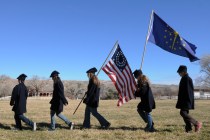Topock Maze a sacred site to Mojave people
Within a stone's throw of busy Interstate 40 near Needles, Calif., a remnant of an ancient American Indian religious site occupies about 15 acres of wind-scoured Mojave Desert. Known as the Topock Maze of the Mystic Maze, the 600-year-old geoglyph consists of intricate patterns of many parallel paths. On the ground, visitors discern undulating parallels following the contours of the desert. From space, satellite images reveal the man-made intricacies of design.
The site still figures importantly in the religious beliefs of the native Mojave people whose ancestors scraped the pathways into the desert pavement of stones darkened by a natural mineral varnish. The removed stones formed windows outlining the lighter pathways. Early experts thought the site involved purification rites of warriors returning from battle who ran through the maze to leave bad spirits behind. Modern Mojave people explain that the site receives the souls of the departed where the bad souls get lost and the good ones find a portal to an afterlife.
To reach the Topock Maze, drive south from Las Vegas on U.S. 95, crossing the Nevada-California border south of the turnoff toward Laughlin. Note the highest peak in the Newberry Mountains to the east where the Laughlin traffic heads. This is Spirit Mountain, a key sacred site for the Aha Makav, the Mojave people near the Colorado River, whose ancestral lands lie along both sides from Black Canyon and Hoover Dam downriver to south of Blythe, Calif.
Continue toward Needles when you reach I-40. As you near the river, watch for the Moabi exit about 10 miles before you get to Needles. At a junction just off the freeway, turn left. Follow the pavement to its end and turn left again onto a well-maintained graded road. Drive about a mile. The Topock Maze lies on the north side of this road, fenced off for protection from vandals. Listed on the National Register of Historic Places in 1978, the Topock Maze falls under the protection of the U.S. Fish and Wildlife Service.
Lying undisturbed and respectfully regarded for hundreds of years, the Topock Maze suffered assaults in modern times that drastically reduced its original size of about 50 acres. When the Southern Pacific Railroad reached the river in the 1880s, it bridged the turbulent flow with the first of many structures and laid track right through the middle of the maze. It also destroyed a huge geoglyph of a human figure holding a snake that had its feet near the riverbank.
Soon the area had wagon roads as well as tracks. In 1926, U.S. 66, the nation's "Mother Road," skirted the maze. In the 1950s, the Pacific Gas and Electric utility built a gas pipeline in the area, just missing the ancient site. Interstate 40 replaced the U.S. 66 in the 1970s, vastly wider, but still missing the remaining one-third of the Topock Maze.
PG&E built a pumping station near the maze to boost the gas in the pipeline. It used a very toxic product to prevent rust in the pipeline and routinely dumped it near the maze. Turns out the poisonous compound causes cancer, leaches into the soil and can get into the ground water.
Called Chromium 6, the toxin gained fame as the chemical culprit in the movie "Erin Brockovich," a true saga set elsewhere in Southern California. When tests several years ago proved the toxic plume was indeed headed for the Colorado River, a massive and expensive cleanup of contaminated soils near the maze began. PG&E sought emergency permission to build a water processing plant to combat the toxic plume, and, incidentally, to save a lot of money on soil removal. The new plant arose right next to the Topock Maze.
Concerned about this latest assault on their ancient heritage, the Mojave people based at Fort Mojave Reservation about 20 miles upriver determined to put up a fight against the giant utility's most recent intrusion. They began a campaign of meetings, marches and media attention that spotlighted the problems at the Topock Maze. In November 2006, PG&E publicly apologized to the Mojave people and promised future removal of the encroaching facility. The People of the River continue to keep watch over their ancient religious site.
Margo Bartlett Pesek's column appears on Sundays.






















